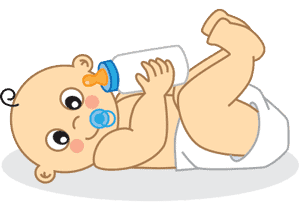Baby Sleep Patterns Explained
Many parents want to know if their baby’s sleep patterns are normal and how they can create healthy baby sleep patterns.
Here is handy chart which summarizes the sleep recommendations from the Canadian Paediatrics Society.
These are the total hours recommended in a 24-hour period.

This is an average and some children may need a little more sleep or a little less, but this chart reminds us that babies and children need a lot of sleep! Our lives have gotten busier, but our sleep needs haven’t changed.
Adults don’t always get the recommended 7-9 hours of sleep per night, but we can help our children get the sleep they need for their developing minds and bodies.
Depending on the age of the child, total amount of sleep will vary, as well as the timing of sleep.
As your child gets older, baby sleep patterns will change which I’ve outlined below.
1-8 Weeks
Your newborn’s baby sleep patterns will be very un-organized. The main factor determining when they will sleep is the homeostatic sleep drive, which means that the longer they’re awake, the stronger the drive to sleep will become. To avoid them becoming overtired, make sure you nap them frequently and keep the awake time short – 1 to 2 hours only. This may mean anywhere from 3 to 6 naps during the day. Due to the variability of nap times and length, bedtime will be variable and usually later.
At this age day/night confusion is also possible and they may want to sleep more during the day and less at night. To help reverse this day/night confusion, keep the lights on during nap time and keep it dark and quiet at night.

2-6 Months
Any day/night confusion should have resolved itself by this age. Your baby’s sleep patterns will change as they should be sleeping in longer stretches at night and getting about 3 to 4 naps during the day. Continue to keep short awake times between naps, and watch for an earlier bedtime. As your baby gets older, their bedtime will naturally start to creep earlier.

6-12 Months
By 6 months of age your child’s internal circadian biological clock is developed which regulates the sleep/wake cycle throughout the day. If naps are offered during a sleep wave, they will fall asleep easier and get a more restorative nap. Offer consistent nap times each day to help their internal clock set, making it easier for them to fall asleep and for you to plan your day! Your child will have 3 naps until about 8 months of age, at which time the 3rd nap will drop. Bedtime should be more consistent also, usually about 4 hours after their early afternoon nap.

1-3 Years
The major change to baby sleep patterns during this age range is the 2 to 1 nap transition. The average age that children drop their morning nap is 15-18 months old. Bedtime should remain relatively consistent, or slightly earlier as you work through the nap transition. Your child will need about 10-12 hours of sleep overnight.

3-5 Years
90% of children are still napping at the age of 3, and your child will most likely drop their last nap sometime during their 3rd year. They may nap some days and not other days, but it’s important to continue to offer quiet time in the afternoon to allow their minds and bodies to rest. Bedtime may move slightly later, but they still need about 10-12 hours of sleep overnight.

6-10 Years
Your child won’t be napping at this age, but they still need an adequate amount of sleep overnight.
The recommended amount of sleep is still 10-12 hours, so determine bedtime based on when your child typically wakes in the morning.
If your child wakes at 6am, they will need a bedtime between 6pm and 8pm.
Every Child Is Different
Every child’s sleep needs are different, but there are signs you can watch for to determine if they are getting enough sleep.
Signs your child may not be getting enough sleep include falling asleep easily in the car, waking from a nap crying, irritable and fussy towards the end of the day, waking frequently throughout the night and waking really early in the morning.
If your child is showing these signs, the easiest way to help them refill their sleep tank is to implement an earlier bedtime.














